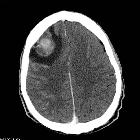Neoplastic intracranial aneurysm
Neoplastic intracranial or cerebral aneurysms, also known as oncotic aneurysms, are a rare type of intracranial aneurysm attributed to metastatic tumor emboli.
Epidemiology
The entity is rare, with fewer than 100 cases being reported in the English literature at the time of a 2015 systematic review .
Clinical presentation
Patients most often present with neurologic deficits, headache, or altered mental status due to intracranial hemorrhage.
Pathology
Etiology
The most common causes are as follows :
- cardiac myxoma (60%)
- choriocarcinoma (26%)
Less commonly reported causes are lung carcinoma (14%), lymphoma, and cardiac myxosarcoma .
Location
Neoplastic aneurysms are most commonly located in peripheral branches of the anterior circulation .
Those due to myxoma are often multiple, while those due to choriocarcinoma are solitary .
Radiographic features
CT
Non-contrast CT may demonstrate peripheral intracerebral hemorrhages or subarachnoid hemorrhage.
Angiography (DSA)
Catheter angiography is the most sensitive modality for detection of neoplastic aneurysms given their small size and peripheral location. These appear as small, irregular, usually fusiform aneurysms in branches of the middle cerebral artery and anterior cerebral artery . Flow through the aneurysm is often slow and may be only appreciated as areas of delayed washout .
Treatment and prognosis
Aneurysms secondary to cardiac myxoma carry a better prognosis as the myxoma induces a connective tissue proliferation in the vascular wall that protects against rupture . Most are treated conservatively .
In contrast, the vast majority of carcinoma-related aneurysms present with intracranial hemorrhage . Most are treated with surgery or chemotherapy .
History and etymology
The first radiologic observations of cerebral aneurysms attributed to myxoma emboli were reported in Radiology in 1966 . Another group of radiologists presented radiologic-pathologic correlation of a case of these aneurysms for the first time at the meeting of the Radiological Society of North America in 1969 and proposed that the neoplastic variety be added to the classical types of intracranial aneurysm . These reports notwithstanding, a set of neurosurgeons claimed to publish the first case of myxoma tumor emboli-induced cerebral aneurysm in the New England Journal of Medicine in 1970 .
Differential diagnosis
Other causes of intracranial aneurysm should be considered. In particular, the angiographic configuration of neoplastic intracranial aneurysms is similar to that of mycotic aneurysms .
Causes of lobar hemorrhage other than aneurysms include amyloid angiopathy, hypertension, and arteriovenous malformation.
Siehe auch:

 Assoziationen und Differentialdiagnosen zu Neoplastic intracranial aneurysm:
Assoziationen und Differentialdiagnosen zu Neoplastic intracranial aneurysm:


